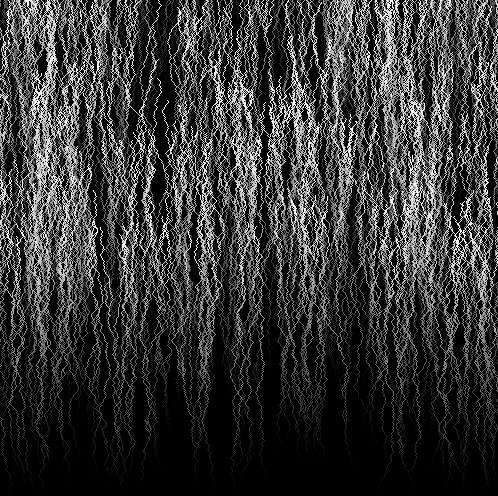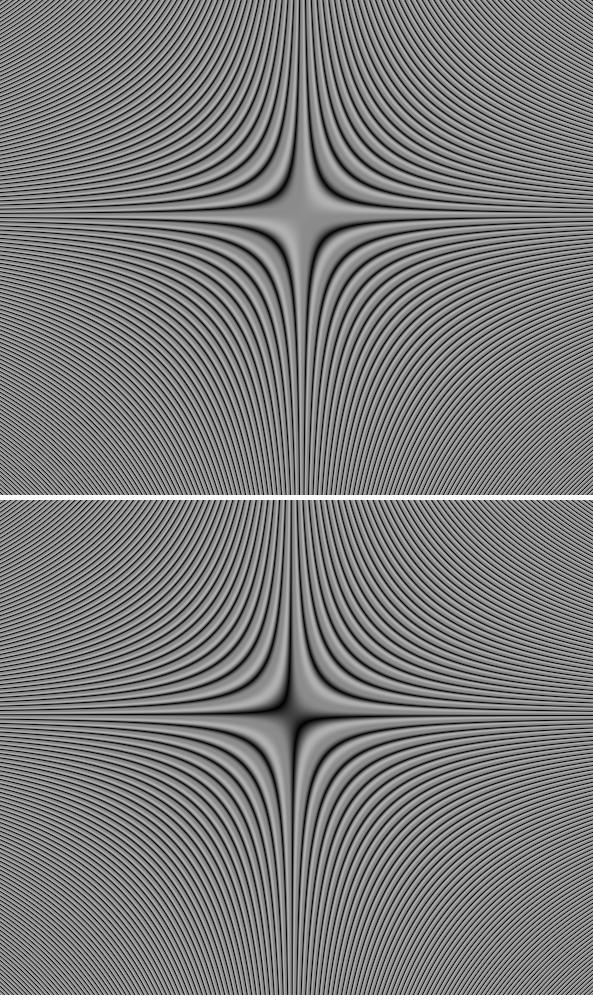Actionscript:
-
[SWF(width=500, height=500)]
-
var canvasSize:int=stage.stageWidth;
-
var canvas:BitmapData=new BitmapData(canvasSize,canvasSize,false,0x000001);
-
addChild(new Bitmap(canvas, "auto", true));
-
var size:int=canvas.width*canvas.height - canvasSize;
-
var pixels:Vector.<uint>=canvas.getVector(canvas.rect);
-
for (var i:int = 0; i<canvasSize; i++) {
-
var xp:int=int(Math.random()*canvasSize);
-
var yp:int=int(Math.random()*canvasSize);
-
pixels[xp+yp*canvasSize]=0xFF000000;
-
}
-
var targetCol:uint=0xFF000000;
-
var buffer:Vector.<uint>=pixels.concat();
-
var fade:uint=1;
-
-
addEventListener(Event.ENTER_FRAME, onLoop);
-
function onLoop(evt:Event):void {
-
var curr:uint=targetCol;
-
var r:int = (curr>> 16) & 0xFF;
-
var g:int = (curr>> 8) & 0xFF;
-
var b:int=curr&0xFF;
-
r+=fade;
-
g+=fade;
-
b+=fade;
-
if (r>255) r=255;
-
if (g>255) g=255;
-
if (b>255) b=255;
-
var darker:uint=0xFF000000|r<<16|g<<8|b;
-
if (darker==0xFFFFFFFF) {
-
removeEventListener(Event.ENTER_FRAME, onLoop);
-
}
-
for (var i:int = canvasSize; i<size; i++) {
-
curr=pixels[i];
-
if (curr==targetCol) {
-
var index:int=i-canvasSize+int(Math.random()*3) - 1;
-
if (index>0) buffer[index]=darker;
-
if (int(Math.random()*50)==1) {
-
index=i-canvasSize+int(Math.random()*3)-1;
-
if (index>0) buffer[index]=darker;
-
}
-
}
-
}
-
targetCol=darker;
-
canvas.lock();
-
canvas.setVector(canvas.rect, buffer);
-
pixels=buffer.concat();
-
canvas.unlock();
-
}
This snippet uses setVector() to draw something that looks like this:

This is a cellular automaton. It has kind of a strange rule set - but you could easily use this snippet to do more traditional cellular automata.
Actionscript:
-
var canvasSize:int = 400;
-
var canvas:BitmapData = new BitmapData(canvasSize, canvasSize, false, 0xFFFFFF);
-
addChild(new Bitmap(canvas));
-
var size:int = canvas.width * canvas.height;
-
var pixels:Vector.<uint> = canvas.getVector(canvas.rect);
-
-
addEventListener(Event.ENTER_FRAME, onLoop);
-
function onLoop(evt:Event):void {
-
for (var i:int = 0; i<500; i++){
-
fillCircle(int(Math.random() * canvasSize),
-
int(Math.random() * canvasSize),
-
int(Math.random() * 5 + 3),
-
uint(Math.random() * 0xFFFF));
-
}
-
canvas.lock();
-
canvas.setVector(canvas.rect, pixels);
-
canvas.unlock();
-
}
-
-
function fillCircle(xp:int,yp:int, radius:int, col:uint = 0x000000):void {
-
var xoff:int =0;
-
var yoff:int = radius;
-
var balance:int = -radius;
-
while (xoff <= yoff) {
-
var p0:int = xp - xoff;
-
var p1:int = xp - yoff;
-
var w0:int = xoff + xoff;
-
var w1:int = yoff + yoff;
-
hLine(p0, yp + yoff, w0, col);
-
hLine(p0, yp - yoff, w0, col);
-
hLine(p1, yp + xoff, w1, col);
-
hLine(p1, yp - xoff, w1, col);
-
if ((balance += xoff++ + xoff)>= 0) {
-
balance-=--yoff+yoff;
-
}
-
}
-
}
-
function hLine(xp:int, yp:int, w:int, col:uint):void {
-
var index:int = xp + yp * canvasSize;
-
for (var i:int = 0; i <w; i++){
-
index++;
-
if (index> -1 && index <size){
-
pixels[index] = col;
-
}
-
}
-
}
In the past I've posted examples of Bresenham's Circle (here and here). Both of those examples make use of setPixel(). Today's snippet demos a version of Bresenham's Circle that works with setVector().
Actionscript:
-
var canvas:BitmapData=new BitmapData(400,400,false,0x000000);
-
addChild(new Bitmap(canvas));
-
var pix:Vector.<uint>=canvas.getVector(canvas.rect);
-
-
canvas.lock();
-
for (var i:int = 0; i<300; i++) {
-
var xp:int=50+i;
-
var yp:int=50+i/2;
-
// target x and y coords in 1D array
-
pix[xp+yp*400]=0xFFFFFF;
-
}
-
canvas.setVector(canvas.rect, pix);
-
canvas.unlock();
This snippet shows how to target x and y coordinates in a 1D Array / Vector. This can be useful sometimes when working with setVector().
This is sort of like re-inventing setPixel().... and for that reason is kind of pointless - that said, it's interesting to know. I first learned about this technique from using processing.
Actionscript:
-
[SWF(width=600,height=500,frameRate=30)]
-
var canvas:BitmapData=new BitmapData(600,500,false,0x000000);
-
addChild(new Bitmap(canvas));
-
var size:Number=canvas.width*canvas.height;
-
var w:Number=canvas.width;
-
var wd:Number=1/w;
-
var pix:Vector.<uint> = new Vector.<uint>();
-
var sin:Number;
-
var cos:Number;
-
var dx:Number=110;
-
var dy:Number=52;
-
addEventListener(Event.ENTER_FRAME, onLoop);
-
function onLoop(evt:Event):void {
-
dx+=0.001;
-
canvas.lock();
-
for (var i:int = 0; i<size; i++) {
-
var xp:Number=i%w;
-
var yp:Number=int(i*wd);
-
var xx:Number=xp*0.05+dx;
-
var yy:Number=yp*0.05+dy;
-
var t:Number= (xx * yy) % 3.14159265;
-
//compute sine
-
// technique from http://lab.polygonal.de/2007/07/18/fast-and-accurate-sinecosine-approximation/
-
// by Michael Baczynski
-
if (t<0) {
-
sin=1.27323954*t+.405284735*t*t;
-
} else {
-
sin=1.27323954*t-0.405284735*t*t;
-
}
-
//compute cosine: sin(t + PI/2) = cos(t)
-
t+=1.57079632;
-
if (t>3.14159265) {
-
t-=6.28318531;
-
}
-
if (t<0) {
-
cos=1.27323954*t+0.405284735*t*t;
-
} else {
-
cos=1.27323954*t-0.405284735*t*t;
-
}
-
var c:Number=sin+cos*cos*cos;
-
// fast math abs
-
c=c<0? -c:c;
-
c=c*140;
-
// math max 255
-
c=c>255?255:c;
-
pix[i]=c<<16|c<<8|c;
-
}
-
canvas.setVector(canvas.rect, pix);
-
canvas.unlock();
-
}
The above snippet will animate a gradient that looks like this:


